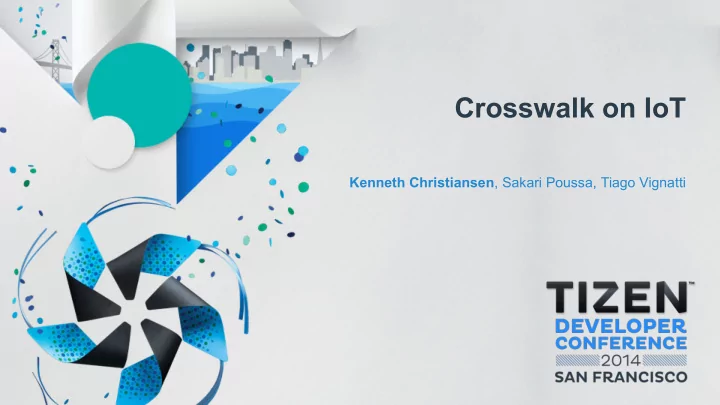

Crosswalk on IoT Kenneth Christiansen , Sakari Poussa, Tiago Vignatti
Session goals: What IoT means to Crosswalk from the graphics perspective ● Introduce a new graphics architecture for IoT ● Next challenges ● 2
Tizen graphics, IoT and Crosswalk
Tizen Graphics • Tizen is not much different than traditional Linux distros: • In short: kernel Linux + GL driver + X11 or Wayland Native App: toolkit (EFL or Qt) – – Web App: runtime (WebKitEFL or Crosswalk) • GL graphics context requires several megabytes! (sorry, no reference) Problems on constrained platforms: – memory allocation: GPU driver resources, texture storage, double-buffering etc ● memory bandwidth: texture upload of bitmaps ● 4
IoT • IoT display-based devices: medical monitors, smartwatch, wrist, etc – • hardware are not very capable: – CPU < 1 GHz, memory < 512 MB, no GPU • system is somewhat simple: e.g. one fullscreen web app at each time – simple window management ● simple UI ● 5
Crosswalk (1/2) • Crosswalk is based on Blink and Chromium • It implements Tizen Web APIs for system control • Chromium has a new platform backend system called Ozone: Crosswalk on Tizen IVI uses Ozone-Wayland – – Ozone-Wayland implements Wayland platform for Chromium – There are other Ozone implementations like KMS/DRM, caca, testing, etc 6
Crosswalk (2/2) • We believe that Crosswalk could encompass all IoT needs! Web is the whole system – – a lean graphics architecture is required though 7
a new graphics architecture for IoT
Solving Tizen Graphics issues for IoT • Graphics architecture for IoT has the desired features: 1. Able to run in constrained platforms 2. Simple window management 3. Simple UI • Solution: remove the window system and toolkits – why we'd need it given that apps are fullscreen and Web based? ● choose renderer method – e.g. using software rendering instead GL we potently could reduce memory ● problems 9
How Chromium helps? (1/2) • Ozone: Chromium Ozone backend system lets us to easily switch the platform implementation – – We'd use Ozone KMS/DRM through software composing backend for constrained platforms Ozone KMS/DRM uses double-buffer Skia surfaces, so it's quite capable ● 10
How Chromium helps? (2/2) • Aura: Aura is the UI framework for basic window and input events – – Aura windows only have one graphics surface layer each ( so window management is not really needed at the window system level! ) • Views: Views is Chromium's internal widgets toolkit based on Aura – If desired, more complex windows decorations can be done using Views (no external – graphics toolkits are needed!) 11
Crosswalk graphics architecture for IoT 12
Conclusion • The new architecture is meant for IoT constrained hw platforms where the Web takes over the whole system – • Less overall complexity due code reduction – Easily we save at least 1 million LoC (window system + toolkits) • Proof-of-concept: – https://github.com/tiagovignatti/crosswalk/commits/embedded Using Tizen Common (“Generic”) – 13
Next Challenges
Next Challenges • Drawback: no Native App option anymore for Tizen Everything goes through Chromium architecture – – What about NaCl? • Are we fine with Web performance for the UI? • Send code to upstream Tizen and Crosswalk 15
Questions? Thank you!
Recommend
More recommend